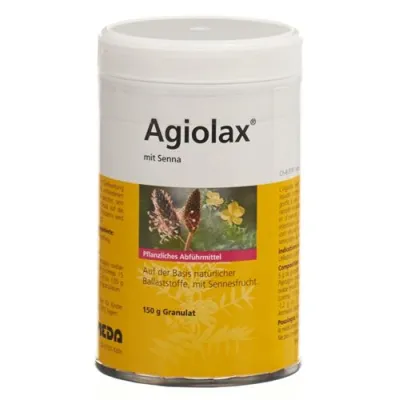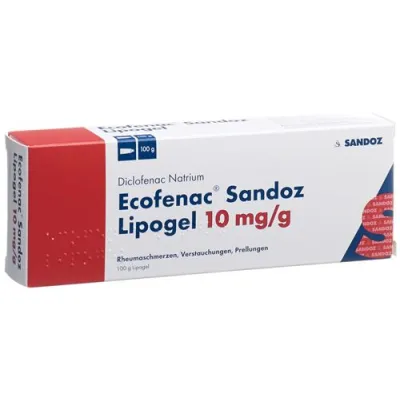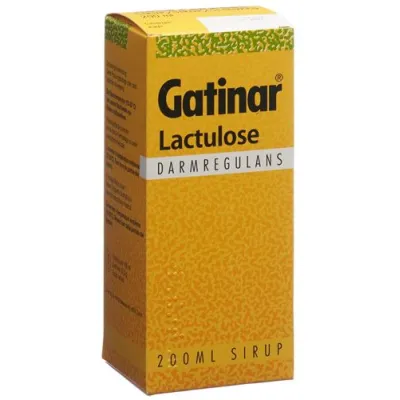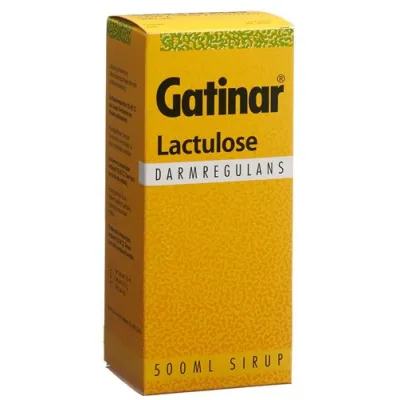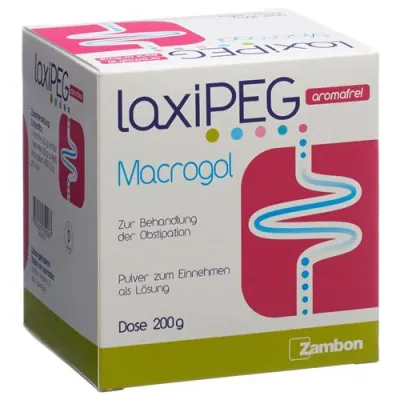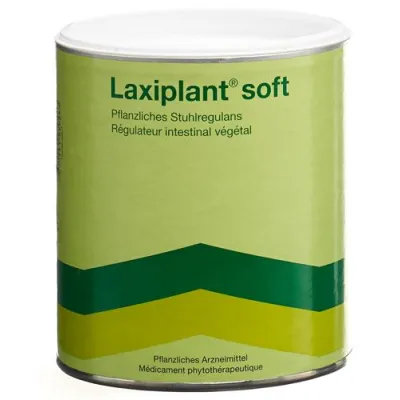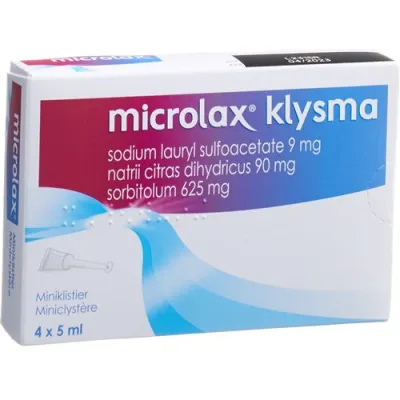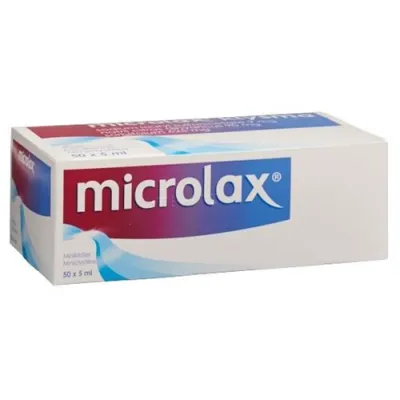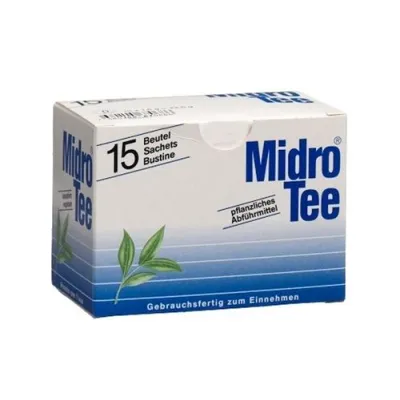Constipation
(1 Pages)
Agiolax with senna granules (d) can 150 g
Agiolax with senna is a herbal laxative based on psyllium and senna for short-term use in occasional constipation. The components psyllium and psyllium husk (Plantago ovata) increase the volume of the stool in the intestine. These ingredients in the granules swell to a multiple of their volume when they absorb water. This stimulates intestinal activity and creates a smooth, soft intestinal contents. The senna contained in the granulate has a laxative effect. Swissmedic-approved patient informationAgiolax® with senna, granules 150 gMEDA Pharma GmbHHerbal medicinal product What is Agiolax with Senna and when is it used?Agiolax with Senna is a herbal laxative based on psyllium and senna, for short-term use in occasional constipation. The components psyllium and psyllium husk (Plantago ovata) increase the volume of the stool in the intestine. These ingredients in the granules swell to a multiple of their volume when they absorb water. This stimulates intestinal activity and creates a smooth, soft intestinal contents. The senna contained in the granulate has a laxative effect. What should be considered?Make sure you drink enough fluids! Delayed absorption may occur when other drugs are administered at the same time. Therefore, before using Agiolax with Senna, a gap of half an hour to one hour should be observed after taking other medicines. If you suffer from constipation, you should eat fiber-rich food (vegetables, fruit, wholemeal bread),take plenty of fluids regularly andensure physical activity (sport)!In the case of chronic constipation, it is advisable to see a doctor who may be able to treat the cause. When should Agiolax with Senna not be taken or only with caution? Agiolax with senna must not be taken in the case of all diseases of the gastrointestinal tract, especially pathological constrictions in the oesophagus, gastrointestinal tract, large diaphragmatic hernia, acute inflammatory diseases of the intestine (e.g. Crohn's disease, Ulcerative colitis, appendicitis), abdominal pain of unknown cause, nausea, vomiting, constipation, difficulty swallowing (risk of shortness of breath), severe dehydration with loss of fluids and salts/minerals and in the case of difficult-to-control diabetes (diabetes mellitus), pregnancy or breastfeeding and hypersensitivity to one of the active ingredients or excipients (see «What does Agiolax with Senna contain?»). Children under the age of 12 should not take Agiolax with Senna. Agiolax with Senna should not be taken if you are suffering from acute or persistent gastrointestinal symptoms, nausea or vomiting, as these symptoms may indicate a possible intestinal obstruction. For this reason, Agiolax with Senna should only be taken under medical supervision at the same time as medication that inhibits intestinal activity (e.g. -type painkillers) (risk of intestinal obstruction). Laxatives should only be taken occasionally and for no longer than a week because of possible habituation. Long-term treatments should be under medical supervision. With chronic use/abuse or use in excess of recommended doses, diarrhea with dehydration and salt/mineral imbalance (especially potassium depletion) may occur. Particular care is therefore required in patients who are simultaneously taking certain water-repellent medicines (diuretics), medicines or foods containing liquorice root (e.g. liquorice), medicines containing cortisol, certain anti-allergic medicines, medicines for heart muscle weakness (cardiac glycosides such as digoxin) and certain medicines for heart rhythm disorders (antiarrhythmics) or are taking thyroid preparations (levothyroxine). Caution is also advised if you suffer from kidney disease. In these cases, consult your doctor before taking Agiolax with Senna. Please only take Agiolax with Senna after consulting your doctor if you know that you suffer from a sugar intolerance. Tell your doctor, pharmacist or druggist if you suffer from other diseases,have allergies ortake other medicines (including those you bought yourself!). Can Agiolax with Senna be taken during pregnancy or while breastfeeding?Agiolax with Senna must not be used during pregnancy or while breastfeeding. How do you use Agiolax with Senna?Swallow Agiolax with Senna whole with at least ¼ l of liquid (water, tea, milk, fruit juice) and then drink plenty of liquid again . The granules can also be taken mixed with yoghurt. In addition, plenty of fluids should be drunk. Adults and adolescents over 12 years: Take 1-2 measuring spoons of Agiolax with Senna in the evening after a meal or in the morning before breakfast; maximum 2 scoops (10 g) / day. The individually correct dosage is the lowest required to obtain a soft-formed stool. Agiolax with Senna should not be taken immediately before bedtime and in an upright position. If the symptoms decrease, the intake can be reduced to every 2nd or 3rd day. Use no longer than 1 week. The use and safety of Agiolax with Senna in children under 12 years of age has not been tested. Stick to the dosage given in the package leaflet or as prescribed by your doctor. If you think the medicine is too weak or too strong, talk to your doctor, pharmacist or druggist. What side effects can Agiolax with Senna have?The following side effects can occur when taking or using Agiolax with Senna: When taking Agiolax with Senna, gas may occur and there is a risk of blockage of the esophagus or intestines, especially if not drinking enough fluids. Hypersensitivity reactions (reddening of the skin, itching, eczema) may occur after ingestion or contact with the skin. The frequency is not known. In this case, a doctor must be consulted immediately. Abdominal pain, abdominal cramps and diarrhea can also occur, especially in patients with irritable bowel syndrome. These symptoms can also be the result of an individual overdose. In such cases, a reduction in dosage is necessary. Nausea and vomiting may occur. The frequency is not known. Very rarely (affects less than 1 user in 10,000) anaphylactic reactions may occur. An overdose leads to increased side effects, it can lead to heart problems and muscle weakness, in the long term the liver can be damaged. Furthermore, the intestinal mucosa and the urine can turn yellow-reddish-brown, which usually disappears after the drug is stopped. If you get any side effects, talk to your doctor, pharmacist or druggist. This also applies in particular to side effects that are not listed in this leaflet. What else needs to be considered?The medicinal product may only be used up to the date marked «EXP» on the container. Use by after openingShelf life 6 months after opening. Storage InstructionsStore at room temperature (15-25 °C). Keep out of reach of CHILDREN. Further informationYour doctor, pharmacist or druggist can provide you with further information. These people have the detailed information for specialists. What does Agiolax with Senna contain?5 g granules (= 1 measuring spoon) contain: Active ingredientsIndian psyllium (Plantago ovata Forssk., semen) 2.6 g, Indian psyllium husks (Plantago ovata em> Forssk., semenis tegumentum) 0.11 g, senna fruits (Senna alexandrina Mill., fructus) 0.34-0.66 g, corresponding to 15 mg sennosides (calculated as sennoside B). ExcipientsThis medicine also contains: Sucrose, Talc, Gum Arabic, Black Iron Oxide (E172), Yellow Iron Oxide (E172), Red Iron Oxide (E172), Titanium Dioxide (E171), Liquid Paraffin, Hard Paraffin, Sage Oil, Peppermint Oil, Caraway Oil. 1 scoop contains 0.9 to 1.2 g of sucrose. Approval number26821 (Swissmedic) Where can you get Agiolax with Senna? What packs are available?In pharmacies and drugstores, without a doctor's prescription. Packs of 150 g granules. Authorization holderMEDA Pharma GmbH, 8602 Wangen-Brüttisellen. This leaflet was last checked by the medicines authority (Swissmedic) in October 2022. [Version 203 D] ..
42.97 USD
Aptamil comfort 2
Description: The Aptamil Confort 2 EaZypack 800 g is a specially formulated infant milk suitable for babies aged 6-12 months who have developed colic, constipation, or other digestive discomforts. This product is designed with a unique blend of ingredients that can help soothe and relieve digestive issues within 24 hours. Features: Easy to digest formula that is gentle on babies' tummies Contains partially hydrolysed protein that reduces the amount of lactose in the milk Enriched with prebiotics that promote the growth of beneficial bacteria in the gut Has a blend of essential vitamins and minerals that support the overall development of your baby EaZypack packaging makes it convenient to use and store Benefits: Can relieve colic, constipation, and other digestive discomforts within 24 hours Suitable for babies who have difficulty digesting regular milk Can help prevent future digestive issues Supports your baby's growth and development EaZypack makes it easy to take on-the-go Directions for use: Wash your hands before preparing the milk. Use the feeding guide on the pack to measure out the required amount of formula. Add the formula to previously boiled and cooled water (40°C). Close the bottle and shake well until the powder is fully dissolved. Test the temperature before giving it to your baby. Use within two hours of preparation. Ingredients: Skimmed milk, lactose (from milk), vegetable oils, partially hydrolysed whey protein concentrate (from milk), lactulose, emulsifier (citric acid ester of mono- and diglycerides), potassium dihydrogen phosphate, fish oil, calcium chloride, sodium chloride, choline chloride, vitamin C, taurine, ferrous sulphate, inositol, zinc sulphate, vitamin E, L-carnitine, niacin, pantothenic acid, folic acid, copper sulphate, vitamin A, biotin, vitamin B1, vitamin B12, vitamin D3, vitamin B6, manganese sulphate, potassium iodide, vitamin K1, sodium selenite. ..
73.42 USD
Bekunis dragées 5 mg bisacodyl can 30 pcs
What are Bekunis Dragées Bisacodyl and when are they used? Bekunis Dragées Bisacodyl is a laxative that acts on the colon. It triggers the stool-promoting movement of the large intestine. Bekunis Dragées Bisacodyl can also be administered when pressure has to be avoided, e.g. in the case of haemorrhoids and anal cracks. Bekunis Dragées Bisacodyl are used in the short term for constipation, constipation due to bed rest, unfamiliar food or when travelling. Before X-rays in the gastrointestinal area and before operations, Bekunis Dragées Bisacodyl help to empty the bowel.What should be considered? Medical advice is required for children and patients with serious illnesses. In the case of chronic constipation, its origin must be determined by the doctor. Long-term treatment must be under medical supervision.General informationIf you are constipated, you should, if possible, eat fiber-rich food (vegetables, fruit, wholemeal bread) and drink plenty of fluids regularly and pay attention to physical activity (sport).When should Bekunis Dragées Bisacodyl not be used? Bekunis Dragées Bisacodyl must not be used if there is a known hypersensitivity to the active ingredient or one of the ingredients (galactose and fructose intolerance: see "When should caution be exercised when taking/using Bekunis Dragées Bisacodyl"), in the case of intestinal constriction, intestinal obstruction (ileus), acute diseases in the abdominal cavity such as acute appendicitis and acute intestinal inflammation as well as severe abdominal pain in combination with nausea and vomiting, which indicate a serious illness interpret. Bekunis Dragées Bisacodyl must not be used in the case of severe fluid and potassium deficiency.When is caution required when taking Bekunis Dragées Bisacodyl? Bekunis Dragées Bisacodyl should only be given to children under the age of 12 if recommended by a doctor. As with all laxatives, continuous daily use over a period of more than 1-2 weeks is not indicated for Bekunis Dragées Bisacodyl. If laxatives are used daily, the cause of the constipation should be investigated. Long-term treatments belong under medical supervision. With long-term or high-dose use, water and mineral losses (potassium) can occur and lead to disorders of the heart muscle function and muscle weakness as well as an increase in constipation. Patients who take diuretic drugs, oral corticosteroids or digitalis preparations should only take Bekunis Dragées Bisacodyl after consulting their doctor. In very rare cases, patients who have taken Bekunis Dragées Bisacodyl have experienced dizziness or short-term unconsciousness (syncope). According to the corresponding case reports, this is probably due to syncope, which is either due to the purging process itself, to straining or to vascular reactions mediated via the nervous system due to abdominal pain caused by constipation, but not necessarily to the use of Bekunis Dragées Bisacodyl itself. One Bekunis Dragée Bisacodyl contains 226 mg lactose and 88.34 mg sucrose. When treating constipation in adults and children over 12 years of age, this equates to up to 452 mg lactose and 176.68 mg sucrose daily. Patients with a rare hereditary galactose intolerance, e.g. galactosemia or a rare hereditary fructose intolerance should not take the dragées. Inform your doctor, pharmacist or druggist if you suffer from other diseases, have allergies or otherTake other medicines (including those you bought yourself!) or use them externally!Can Bekunis Dragées Bisacodyl be taken during pregnancy or while breastfeeding? As a precaution, you should avoid taking medicines during pregnancy and breastfeeding. Only your doctor can decide whether Bekunis Dragées Bisacodyl can be used during pregnancy or breastfeeding.How do you use Bekunis Dragées Bisacodyl? Unless otherwise prescribed by the doctor: Adults and children over 12 years of age: average single dose: 1 - 2 tablets. Children from 4 - 12 years of age: as prescribed by the doctor. The dragées should be taken in the evening before going to bed so that the bowel movements can take place the next morning. If taken in the evening, after about 10 hours, i.e. without disturbing the night’s sleep, there will be one or two emptyings the next morning. Bekunis Dragées Bisacodyl are swallowed whole with sufficient liquid (no milk). Milk and medicines against gastric hyperacidity should not be taken at the same time as Bekunis Dragées Bisacodyl, otherwise the dragées will dissolve more quickly than desired. If you need an antacid (medicine against acidification of the stomach), take it half an hour after Bekunis Dragées Bisacodyl. Observe the dose given in the package leaflet or prescribed by your doctor. If you think the medicine is too weak or too strong, talk to your doctor, pharmacist or druggist.What side effects can Bekunis Dragées Bisacodyl have? After taking Bekunis Dragées Bisacodyl, you may experience unpleasant sensations such as flatulence and abdominal pain (possibly with nausea and/or vomiting) or diarrhea and inflammation of the colon. Hypersensitivity reactions have also been reported, which in very rare cases can lead to allergic skin reactions and shock (angioneurotic edema, anaphylactic reactions). The occurrence of diarrhea is a sign that the dosage is too high and is only desirable before an X-ray or before an operation.If you notice any side effects that are not described here, you should inform your doctor, pharmacist or druggist.What else should you watch out for? The medicinal product may only be used up to the end of the period marked "Exp." on the container. designated date. Store at room temperature (15 - 25 °C). Keep out of the reach of children. Your doctor, pharmacist or druggist can provide you with further information. These people have the detailed technical information.What does Bekunis Dragées Bisacodyl contain? 1 enteric-coated dragee contains the active substance: 5 mg bisacodyl and excipients. Approval number 55278 (Swissmedic) Where can you get Bekunis Dragées Bisacodyl? What packs are available? In pharmacies and drugstores without a doctor's prescription: Packs of 30 dragees Authorization holder Tentan AG, CH-4452 Itingen Manufacturer roha Arzneimittel GmbH, D-28333 Bremen This package leaflet was last published in March 2022 by the drug authority (p wissmedic).PI038040/05.22..
37.79 USD
Bulboid supp child 10 pcs
Bulboid suppositories contain 98% pure glycerin. This forms a slippery film on the intestinal wall and, by absorbing water from the rectum, softens the hardened stool masses. This also stimulates the intestinal movement (peristalsis) in the corresponding section of the intestine. It is emptied shortly after use. Bulboid glycerine stool suppositories are used for hardened stools and the resulting constipation of the lower sections of the intestine. Bulboid suppositories also make it easier to pass stool if the stool thickens after operations and as a stool aid during pregnancy, during childbirth and while breastfeeding. Swissmedic-approved patient informationBulboïd®Melisana AGWhat is Bulboid and when is it used? Bulboid suppositories contain 98% pure glycerin. This forms a slippery film on the intestinal wall and, by absorbing water from the rectum, softens the hardened stool masses. This also stimulates the intestinal movement (peristalsis) in the corresponding section of the intestine. It is emptied shortly after use. Bulboid glycerine stool suppositories are used for hardened stools and the resulting constipation of the lower sections of the intestine. Bulboid suppositories also make it easier to pass stool if the stool thickens after operations and as a stool aid during pregnancy, during childbirth and while breastfeeding. What should be considered?If you suffer from chronic constipation, we recommend that you see your doctor. When must Bulboid not be used?The medicine must not be used in case of hypersensitivity to one of the ingredients. When is caution required when using Bulboid?If used as directed, no special precautions need to be followed. This medicinal product contains less than 1 mmol sodium (23 mg) per child suppository or adult suppository, i.e. essentially 'sodium-free'. it is almost «sodium-free». Tell your doctor, pharmacist or druggist if you ▪suffer from other diseases, ▪ Have allergies or •Take other medicines (including those you bought yourself!) or use them externally! Can Bulboid be used during pregnancy or breastfeeding?Systematic scientific studies have never been carried out. Based on previous experience, however, there is no known risk for the child when used as intended. Bulboid may be used during pregnancy or while breastfeeding. However, it is advisable to ask your doctor before use. How do you use Bulboid?If necessary, remove a suppository from the wrapper and insert it into the rectum. Adults and children over 12 years of age: 1 Adult Bulboid suppository as needed. Infants and children up to 12 years of age: 1 Bulboid infants and children suppository as needed. The effect occurs after a few minutes, although it is not necessary for the suppository to melt completely. After inserting the suppository, it is advisable to wait a little before emptying the stool so that the glycerin can act on the hardened stool masses in the rectum for a while. Stick to the dosage given in the package leaflet or as prescribed by your doctor. If you think the medicine is too weak or too strong, talk to your doctor, pharmacist or druggist. What side effects can Bulboid have?The following side effects can occur when using Bulboid: Long-term use can lead to irritation of the anus. Bulboid suppositories are not indicated for long-term daily use. If you nevertheless observe side effects, inform your doctor, pharmacist or druggist. What else needs to be considered?The medicinal product may only be used up to the date marked «EXP» on the container. The color of the suppositories may vary from colorless to slightly yellow; this has no effect on the effectiveness and tolerability of the product. Storage Instructions Store at room temperature (15-25°C). Keep out of the reach of children. Further Notes Your doctor, pharmacist or druggist can provide you with further information. These people have the detailed information for specialists. What is in Bulboid?Children's suppositories 1 suppository contains: Active ingredient Glycerol 878 mg (E 422). Excipients Dimethicone, sodium carbonate decahydrate corresp. Sodium 4.8 mg, stearic acid and purified water. Adult suppositories 1 suppository contains: Active ingredient Glycerol 1756 mg (E 422). Excipients Dimethicone, sodium carbonate decahydrate corresp. Sodium 9.6 mg, stearic acid and purified water. Approval number15440 (Swissmedic). Where can you get Bulboid? What packs are available?In pharmacies and drugstores, without a doctor's prescription. In packs of 10 suppositories for infants and children; 10 and 100 Adult suppositories. Authorization holderMelisana AG, 8004 Zurich. This leaflet was last checked by the drug authority (Swissmedic) in December 2004. ..
15.97 USD
Duphalac syrup bottle 200 ml
AMZV What is Duphalac and when is it used? The active ingredient in Duphalac is lactulose, a sugar that does not occur naturally. Since your body cannot digest or absorb Duphalac, it remains in the intestine and reaches the large intestine unchanged. There it causes an increase in acidity due to the conversion by the intestinal flora. This stimulates the colon. A larger amount of water is also retained in the large intestine, which allows for softening of the stool and easier elimination. In addition, the transfer of certain toxic substances from the intestinal contents into the blood circulation is prevented and they are excreted with the stool.Duphalac is taken for constipation, i.e. if you have problems emptying your stool. These difficulties can come in two forms: either no voiding at all, or then small and hard stools. Duphalac helps improve bowel movements. We also recommend that you adjust your daily habits as well. Below is some practical advice that may help you. Lactulose, as a prebiotic substance, can enhance the growth of health-promoting bacteria (such as Bifidobacteria and Lactobacillus) while suppressing potential disease-causing bacteria (such as Clostridium and Escherichia coli).This can result in a more favorable balance in the gut flora.The doctor can also use Duphalac to treat other diseases ( especially for liver disease).What needs to be considered?The following advice can help you break the bad habits that are a common cause of constipation:Regular physical activity.Drink enough water, at least 1.5 liters a day.Never skip a meal or start a diet until your bowels are working properly again.Get started for the day a good breakfast: wholemeal bread, fruit, coffee (not strong tea), yogurt.Don't suppress a bowel movement if you feel it.Never take a laxative for a long time without asking your doctor.Preferably eat unpeeled fruit, raw vegetables, nuts, figs, dried plums, wholemeal bread, rye bread, whey, yogurt.Eat calmly and chew every bite carefully.Avoid toast, white bread, rusks, strong tea, bananas, white rice, hard-boiled eggs.For diabetics15 ml of Duphalac syrup contain a maximum of 2.8 g absorbable carbohydrates.In normal doses, Duphalac can also be taken by diabetics.When can Duphalac not be used? If you are hypersensitive to the active ingredient or any of the ingredients. People who have been prescribed a galactose or lactose-free diet by their doctor should not take Duphalac. If there is an intestinal obstruction other than simple constipation, or if there is a tear or risk of a tear in the digestive tract, Duphalac must not be used. If in doubt, ask your doctor. When should you be careful while taking Duphalac? If after a few days you notice that your stools are too watery, it is enough to reduce the recommended doses. As a precautionary measure, you should consult your doctor before using any laxative in children under 6 years of age. The use of laxative in children should only be carried out exceptionally and under medical monitoring. Patients with the rare hereditary galactosis intolerance, Lapp lactase deficiency, fructose intolerance or glucose galactose malabsorption should not take. lead to the water and electrolyte equilibrium. Search your doctor or yoursConsult your doctor before starting treatment if you have painful abdominal pain of undetermined cause, so that this can be clarified.Inform your doctor, pharmacist or druggist, or your doctor, pharmacist or druggist if younotice after several days that the effectiveness of the drug is insufficient; it may be necessary to adjust the dose.suffer from lactose intolerancesuffer from other diseaseshave allergies ortake other medicines (including those you bought yourself!) or use them externally!Can Duphalac be taken during pregnancy or while breastfeeding?If used as directed, it can be taken during pregnancy and breastfeeding.As a precaution If possible, you should avoid taking medicines during pregnancy and breastfeeding or ask your doctor, pharmacist or druggist for advice.How do you use Duphalac?The dosage of Duphalac depends on your age, the severity of the constipation and how long the constipation has lasted.Duphalac can be taken undiluted or diluted in a warm or cold drink. A single dose should be swallowed immediately and not remain in the mouth for a long time.In the case of a single daily dose, these should be taken at the same time, e.g. during breakfast.ConstipationDuphalac can be taken as a single daily dose or in two divided doses.The initial dose can be individually adjusted after an adequate treatment result has been achieved. It may take some time (2-3 days) for the treatment to take effect. If the effect is too strong (stools too liquid or too large), the daily dose must be reduced or, on the contrary, increased if the effect is too weak.The table below clearly indicates the doses of Duphalac to be taken:Initial dose/day(1st to 3rd day)with prolonged useAdults and adolescents from 14 years15-45 ml10-25 mlChildren (7-14 years)15 ml10 mlChildren (1-6 years)5-10 ml5-10 mlInfants under 1 year≤5 ml≤5 mlThe dose can be measured exactly using the enclosed dosing cup (2.5 to 30 ml).Keep to the dosage given in the package insert or prescribed by the doctor. If you think that the medicine is too weak or too strong, talk to your doctor, pharmacist or druggist.What side effects can Duphalac have?The following side effects can occur when taking Duphalac:Especially at the beginning of treatment, temporary flatulence may occur, which you should not worry about. They are a sign of the effectiveness of Duphalac. During treatment, digestive disorders such as abdominal pain, nausea and vomiting, as well as, in the case of too high doses, diarrhea and disturbances in the water and electrolyte balance. If you notice any side effects that are not described here, you should inform your doctor, pharmacist or pharmacist. What else should you watch out for? The Medicines may only be used by the date marked «EXP» on the container.Store at room temperature (15-25 °C); Do not freeze syrup and protect from sunlight. Keep medicines out of the reach of children! Your doctor, pharmacist or druggist can provide you with further information. These people have the detailed technical information.Whatdoes Duphalac contain?Active ingredient15 ml Duphalac syrup contain 10.01 g lactuloseExcipientsNone; however, sulphites and other sugars such as lactose, galactose and fructose may be present.Authorization number32894 (Swissmedic).Where can you get Duphalac? Which packs are available? In pharmacies and drugstores, without a doctor's prescription: Duphalac, syrup in bottles: 200 ml, 500 ml and bundle pack 12 × 500 ml Authorization holder Mylan Pharma GmbH, 6312 Steinhausen This leaflet was last revised in June 2018 checked by the drug authority (Swissmedic)...
11.89 USD
Duphalac syrup bottle 500 ml
AMZV What is Duphalac and when is it used? The active ingredient in Duphalac is lactulose, a sugar that does not occur naturally. Since your body cannot digest or absorb Duphalac, it remains in the intestine and reaches the large intestine unchanged. There it causes an increase in acidity due to the conversion by the intestinal flora. This stimulates the colon. A larger amount of water is also retained in the large intestine, which allows for softening of the stool and easier elimination. In addition, the transfer of certain toxic substances from the intestinal contents into the blood circulation is prevented and they are excreted with the stool.Duphalac is taken for constipation, i.e. if you have problems emptying your stool. These difficulties can come in two forms: either no voiding at all, or then small and hard stools. Duphalac helps improve bowel movements. We also recommend that you adjust your daily habits as well. Below is some practical advice that may help you. Lactulose, as a prebiotic substance, can enhance the growth of health-promoting bacteria (such as Bifidobacteria and Lactobacillus) while suppressing potential disease-causing bacteria (such as Clostridium and Escherichia coli).This can result in a more favorable balance in the gut flora.The doctor can also use Duphalac to treat other diseases ( especially for liver disease).What needs to be considered?The following advice can help you break the bad habits that are a common cause of constipation:Regular physical activity.Drink enough water, at least 1.5 liters a day.Never skip a meal or start a diet until your bowels are working properly again.Get started for the day a good breakfast: wholemeal bread, fruit, coffee (not strong tea), yogurt.Don't suppress a bowel movement if you feel it.Never take a laxative for a long time without asking your doctor.Preferably eat unpeeled fruit, raw vegetables, nuts, figs, dried plums, wholemeal bread, rye bread, whey, yogurt.Eat calmly and chew every bite carefully.Avoid toast, white bread, rusks, strong tea, bananas, white rice, hard-boiled eggs.For diabetics15 ml of Duphalac syrup contain a maximum of 2.8 g absorbable carbohydrates.In normal doses, Duphalac can also be taken by diabetics.When can Duphalac not be used? If you are hypersensitive to the active ingredient or any of the ingredients. People who have been prescribed a galactose or lactose-free diet by their doctor should not take Duphalac. If there is an intestinal obstruction other than simple constipation, or if there is a tear or risk of a tear in the digestive tract, Duphalac must not be used. If in doubt, ask your doctor. When should you be careful while taking Duphalac? If after a few days you notice that your stools are too watery, it is enough to reduce the recommended doses. As a precautionary measure, you should consult your doctor before using any laxative in children under 6 years of age. The use of laxative in children should only be carried out exceptionally and under medical monitoring. Patients with the rare hereditary galactosis intolerance, Lapp lactase deficiency, fructose intolerance or glucose galactose malabsorption should not take. lead to the water and electrolyte equilibrium. Search your doctor or yoursConsult your doctor before starting treatment if you have painful abdominal pain of undetermined cause, so that this can be clarified.Inform your doctor, pharmacist or druggist, or your doctor, pharmacist or druggist if younotice after several days that the effectiveness of the drug is insufficient; it may be necessary to adjust the dose.suffer from lactose intolerancesuffer from other diseaseshave allergies ortake other medicines (including those you bought yourself!) or use them externally!Can Duphalac be taken during pregnancy or while breastfeeding?If used as directed, it can be taken during pregnancy and breastfeeding.As a precaution If possible, you should avoid taking medicines during pregnancy and breastfeeding or ask your doctor, pharmacist or druggist for advice.How do you use Duphalac?The dosage of Duphalac depends on your age, the severity of the constipation and how long the constipation has lasted.Duphalac can be taken undiluted or diluted in a warm or cold drink. A single dose should be swallowed immediately and not remain in the mouth for a long time.In the case of a single daily dose, these should be taken at the same time, e.g. during breakfast.ConstipationDuphalac can be taken as a single daily dose or in two divided doses.The initial dose can be individually adjusted after an adequate treatment result has been achieved. It may take some time (2-3 days) for the treatment to take effect. If the effect is too strong (stools too liquid or too large), the daily dose must be reduced or, on the contrary, increased if the effect is too weak.The table below clearly indicates the doses of Duphalac to be taken:Initial dose/day(1st to 3rd day)with prolonged useAdults and adolescents from 14 years15-45 ml10-25 mlChildren (7-14 years)15 ml10 mlChildren (1-6 years)5-10 ml5-10 mlInfants under 1 year≤5 ml≤5 mlThe dose can be measured exactly using the enclosed dosing cup (2.5 to 30 ml).Keep to the dosage given in the package insert or prescribed by the doctor. If you think that the medicine is too weak or too strong, talk to your doctor, pharmacist or druggist.What side effects can Duphalac have?The following side effects can occur when taking Duphalac:Especially at the beginning of treatment, temporary flatulence may occur, which you should not worry about. They are a sign of the effectiveness of Duphalac. During treatment, digestive disorders such as abdominal pain, nausea and vomiting, as well as, in the case of too high doses, diarrhea and disturbances in the water and electrolyte balance. If you notice any side effects that are not described here, you should inform your doctor, pharmacist or pharmacist. What else should you watch out for? The Medicines may only be used by the date marked «EXP» on the container.Store at room temperature (15-25 °C); Do not freeze syrup and protect from sunlight. Keep medicines out of the reach of children! Your doctor, pharmacist or druggist can provide you with further information. These people have the detailed technical information.Whatdoes Duphalac contain?Active ingredient15 ml Duphalac syrup contain 10.01 g lactuloseExcipientsNone; however, sulphites and other sugars such as lactose, galactose and fructose may be present.Authorization number32894 (Swissmedic).Where can you get Duphalac? Which packs are available? In pharmacies and drugstores, without a doctor's prescription: Duphalac, syrup in bottles: 200 ml, 500 ml and bundle pack 12 × 500 ml Authorization holder Mylan Pharma GmbH, 6312 Steinhausen This leaflet was last revised in June 2018 checked by the drug authority (Swissmedic)...
25.22 USD
Ecofenac sandoz lipogel 1%tb 100g
What is Ecofenac Sandoz Lipogel and when is it used?Ecofenac Sandoz Lipogel contains the active substance diclofenac, which belongs to a group of medicines called non-steroidal anti-inflammatory drugs (painkillers and anti-inflammatory drugs). . Ecofenac Sandoz Lipogel has painstilling and anti-inflammatory properties and thanks to the watery-alcoholic basis has a soothing, cooling effect. ecofenac Sandoz Lipogel is used to treat pain, inflammation and swelling at: Injuries, ligaments, ligaments and ligaments and Joints e.g. sprains, bruises, strains or back pain after sports or accident; Localized forms of soft tissue rheumatism, such as tendinitis (tennisel arch), shoulder-hand syndrome, bursitis, periarthropathies; and for symptomatic therapy of arthrosis of small and medium-sized joints, such as finger joints or knee . ..
22.03 USD
Gatinar syrup 200ml
Gatinar is used for all forms of constipation, especially -after operations; -during pregnancy and lactation (after consultation with the doctor); -bedridden; -used to treat chronic constipation. The active ingredient in Gatinar - lactulose - is an artificial sugar that cannot be broken down by the human small intestine. It therefore reaches the large intestine unchanged, where it serves as a nutrient for the naturally occurring lactic acid bacteria. This produces acidic breakdown products, mainly lactic acid, which cause the large intestine to become slightly acidic. The putrefactive bacteria are inhibited in their growth and the restoration of the normal intestinal flora is promoted. At the same time, Gatinar and its degradation products have a hydrophilic (osmotic) effect. This will soften the stool and make it easier to empty. Gatinar allows for a natural correction of bowel movements without the risk of habituation or painful irritation. It can also be taken by pregnant women, breastfeeding women and diabetics in the indicated dosages and only after consulting a doctor (see also information below). A few hours after taking Gatinar, infants have soft stools. In adults, the conversion of the intestinal flora takes about 1-2 days. Swissmedic-approved patient informationGatinar® syrupMelisana AGAMZVWhat is Gatinar and when is it used?Gatinar is used in all forms of constipation, especially -after operations; -during pregnancy and lactation (after consultation with the doctor); -bedridden; -used to treat chronic constipation. The active ingredient in Gatinar - lactulose - is an artificial sugar that cannot be broken down by the human small intestine. It therefore reaches the large intestine unchanged, where it serves as a nutrient for the naturally occurring lactic acid bacteria. This produces acidic breakdown products, mainly lactic acid, which cause the large intestine to become slightly acidic. The putrefactive bacteria are inhibited in their growth and the restoration of the normal intestinal flora is promoted. At the same time, Gatinar and its degradation products have a hydrophilic (osmotic) effect. This will soften the stool and make it easier to empty. Gatinar allows for a natural correction of bowel movements without the risk of habituation or painful irritation. It can also be taken by pregnant women, breastfeeding women and diabetics in the indicated dosages and only after consulting a doctor (see also information below). A few hours after taking Gatinar, infants have soft stools. In adults, the conversion of the intestinal flora takes about 1-2 days. What should be considered?If you suffer from chronic constipation, we recommend that you see your doctor. If you are constipated, you should, if possible, eat high-fiber food (vegetables, fruit, wholemeal bread) and drink plenty of fluids regularly and pay attention to physical activity (sport). Note for diabetics: This medicinal product contains 1.8 g of digestible carbohydrates per single dose (10 ml). When should Gatinar not be taken?The preparation should not be taken in diseases of the gastrointestinal tract. Gatinar should not be taken in the case of milk sugar intolerance (lactose intolerance) or a congenital metabolic disease in the infant (galactosemia). When should you be careful when taking Gatinar?Like any laxative, Gatinar can reduce the loss of potassium caused by other medicines (e.g. certain diuretics, corticosteroids, etc.). become, strengthen. This is of particular importance in patients treated with drugs that affect the heart (cardiac glycosides, antiarrhythmics). They should therefore only use Gatinar under strict doctor's instructions. Inform your doctor, pharmacist or druggist if you suffer from other illnesses, have allergies or are taking other medicines (even those you bought yourself!) or using them externally! Can Gatinar be taken during pregnancy or breastfeeding?Based on previous experience, there is no known risk for the child when used as directed. However, systematic scientific investigations have never been carried out. As a precaution, you should avoid taking medicines during pregnancy and breastfeeding or ask your doctor or pharmacist for advice. How do you use Gatinar?Infants Toddlers 1-5 years old Children 6-14 years old Adults 2.5-5 ml daily in a bottle 5-10ml daily in a drink after a meal10-15ml daily in a drink after a meal15-30 ml daily divided into 3 doses of 5-10 ml in a drink after or during meals. For the most accurate dosing, use the enclosed measuring cup. It is strongly recommended to start with the low starting dose. Too high an initial dose could lead to increased gas formation and flatulence, as the bacterial metabolism is temporarily stimulated by restoring the normal intestinal flora. This can be avoided by gradually increasing the daily dose to the individual optimal amount. The rebalancing of the intestinal flora makes it possible to reduce the specified dose after 3-4 days, even in cases of chronic constipation. It is also possible to alternate one or more drug-free days over time. If the constipation lasts only a short time, the drug is of course discontinued after the stool has returned to normal. Stick to the dosage given in the package leaflet or as prescribed by your doctor. If you think the medicine is too weak or too strong, talk to your doctor, pharmacist or druggist. What side effects can Gatinar have?The following side effects can occur when taking Gatinar: In rare cases, especially at the beginning of treatment, the preparation can cause flatulence or abdominal cramps. With high doses, prolonged or too frequent use, diarrhea with loss of water and disturbances in the mineral balance (e.g. loss of potassium) can occur. If you notice side effects that are not described here, you should inform your doctor, pharmacist or druggist. What else needs to be considered?The medicinal product may only be used up to the date marked «EXP» on the container. Your doctor, pharmacist or druggist can provide you with further information. These people have the detailed information for specialists. Gatinar should be kept out of the reach of children. Store at room temperature (15-25°C). What does Gatinar contain?100 ml of Gatinarcontain 67 g of lactulose. Note for diabetics: 10 ml of Gatinar correspond to 0.18 bread units. See the section «What should be considered?». Approval number37585 (Swissmedic). Where can you get Gatinar? What packs are available?In pharmacies and drugstores, without a doctor's prescription. Bottles of 200 ml and 500 ml. Authorization holderMelisana AG, 8004 Zurich. This leaflet was last checked by the drug authority (Swissmedic) in June 2013 . ..
17.25 USD
Gatinar syrup 500ml
What is Gatinar and when is it used? Gatinar is used in all forms of constipation, especially -after operations; -during pregnancy and breastfeeding (after consultation with the doctor); -in the case of bedridden; -to treat chronic constipation human small intestine cannot be broken down. It therefore reaches the large intestine unchanged, where it serves as a nutrient for the naturally occurring lactic acid bacteria. This produces acidic breakdown products, mainly lactic acid, which cause the large intestine to become slightly acidic. The putrefactive bacteria are inhibited in their growth and the restoration of the normal intestinal flora is promoted. At the same time, Gatinar and its degradation products have a hydrophilic (osmotic) effect. This will soften the stool and make it easier to empty. Gatinar allows for a natural correction of bowel movements without the risk of habituation or painful irritation. It can also be taken by pregnant women, breastfeeding women and diabetics in the indicated dosages and only after consulting a doctor (see also information below). A few hours after taking Gatinar, infants have soft stools. In adults, the conversion of the intestinal flora takes about 1-2 days.What should you pay attention to?If you suffer from chronic constipation, we recommend that you consult your doctor. In the event of constipation, you should, if possible, eat fiber-rich food (vegetables, fruit, whole-grain bread) and drink plenty of fluids regularly and exercise (sport). Note for diabetics: This medicine contains 1.8 g of digestible carbohydrates per single dose (10 ml). When shouldn't Gatinar be taken? The preparation should not be taken in diseases of the gastrointestinal tract. Gatinar should not be taken if the infant has milk sugar intolerance (lactose intolerance) or a congenital metabolic disease (galactosemia).When should caution be taken when taking Gatinar?Like any laxative, Gatinar can increase potassium losses caused by other medicines (e.g. certain diuretics, corticosteroids, etc.). This is of particular importance in patients treated with drugs that affect the heart (cardiac glycosides, antiarrhythmics). They should therefore only use Gatinar under strict doctor's instructions.Inform your doctor, pharmacist or druggist, or your doctor, pharmacist or druggist if you suffer from other illnesses, have allergies or are taking other medicines (even those you bought yourself!) or use them externally!Can Gatinar be taken during pregnancy or while breastfeeding?Based on previous experience there is no known risk for the child when used as intended. However, systematic scientific investigations have never been carried out. As a precaution, you should avoid taking medicines during pregnancy and breast-feeding, or ask your doctor or pharmacist for advice.How do you use Gatinar?InfantsToddlers aged 1-5Children aged 6-14Adults2.5–5 ml daily in a bottle5–10 ml daily in a drink after a meal10–15 ml daily in a drink after a meal15-30 ml daily divided into 3 doses of 5-10 ml in a drink after or during meals.For the most accurate dosing, use the enclosed measuring cup.It is highly recommended to use to begin with the low starting dose. Too high an initial dose could lead to increased gas formation and flatulence, as the bacterial metabolism is temporarily stimulated by restoring the normal intestinal flora. This can be avoided by gradually increasing the daily dose to the individual optimal amount. The rebalancing of the intestinal flora makes it possible to reduce the specified dose after 3-4 days, even in cases of chronic constipation. It is also possible to alternate one or more drug-free days over time. If the constipation lasts only for a short time, the drug will of course be discontinued after the stool has returned to normal.Observe the dosage specified in the package insert or prescribed by the doctor. If you think the medicine is too weak or too strong, talk to your doctor, pharmacist or druggist.What side effects can Gatinar have?The following side effects can occur when taking Gatinar:In rare cases, especially at the beginning of treatment, the preparation can cause flatulence or abdominal cramps. With high doses, prolonged or too frequent use, diarrhea with loss of water and disturbances in the mineral balance (including loss of potassium) can occur.If you notice any side effects that are not described here, you should inform your doctor, pharmacist or druggist.What else needs to be considered?The medicine may only be used up to the date marked "EXP" on the container.Your doctor, pharmacist or druggist can provide you with further information. These people have the detailed technical information. Gatinar should be kept out of the reach of children. Store at room temperature (15-25°C). What does Gatinar contain? 100 ml of Gatinar contain 67 g of lactulose. Note for diabetics: 10 ml of Gatinar correspond to 0.18 bread units. See the section «What should be considered?».Approval number37585 (Swissmedic).Where can you get Gatinar? Which packs are available? In pharmacies and drugstores, without a doctor's prescription. Bottles of 200 ml and 500 ml. Authorization holder Melisana AG, 8004 Zurich. This leaflet was last checked by the drug authority (Swissmedic) in June 2013....
33.93 USD
Laxipeg powder flavor-free can 200 g
What is Laxipeg/- aromafrei and when is it used? Laxipeg/- aromafrei is an osmotically active laxative made from macrogol, which enables stool regulation in the event of constipation. Macrogol is an indigestible substance that binds water. This stimulates intestinal activity, making the stool softer and more slippery. This makes bowel movements easier.Laxipeg/- aromafrei is used in adults and children to regulate bowel movements in the case of sluggish bowels and constipation of various origins (constipation).What should be considered? Laxipeg/- flavor free contains neither sugar nor polyols and can therefore also be taken by diabetics or patients who follow a galactose-free diet. If you suffer from constipation, you should You eat fiber-rich food (vegetables, fruit, wholemeal bread) and drink plenty of fluids regularly and pay attention to physical activity (sport).When should Laxipeg/- aromafrei not be taken? Laxipeg/- aromafrei should not be taken if you are known to be hypersensitive to one of the ingredients, if you have severe inflammatory bowel and colon diseases (e.g. ulcerative colitis, Crohn's disease), a disruption in the intestinal passage as a result of intestinal paralysis or an intestinal obstruction (ileus), an intestinal perforation (perforation), or the risk of intestinal perforation, with abdominal pain of undetermined origin.When should caution be taken when taking Laxipeg/- aromafrei?In children over the age of 6 Months to 2 years and with a body weight of at least 6 kg, the drug may only be used after consultation with the doctor. Laxipeg/- aromafrei should not be used on younger or lighter children. If the symptoms of constipation persist after 2 weeks, you should see your doctor. Elderly patients, patients with impaired liver or kidney function, and patients taking diuretics should contact a doctor if diarrhea occurs to consider checking electrolytes.If you need to thicken fluids to To be able to swallow them safely, Laxipeg/- aromafrei can counteract the effect of the thickening agent.Tell your doctor, pharmacist or druggist if yousuffer from other diseases,have allergies ortake other medicines (including those you bought yourself!) or use them externally.Can Laxipeg/- aromafrei be taken during pregnancy or while breastfeeding?Based on previous experience, there is no known risk for the child when used as directed. However, systematic scientific investigations have never been carried out. As a precaution, you should avoid taking medicines during pregnancy or ask your doctor, pharmacist or druggist for advice.The active ingredient is not absorbed by the digestive tract and therefore does not enter the bloodstream or via breast milk.Laxipeg/- aromafrei can be taken while breastfeeding.How do you use Laxipeg/- aromafrei?General informationChildren should not take Laxipeg/- aromafrei for longer than 3 months.The dose can be adjusted depending on the effect achieved.The daily dose can be taken in one dose or in two Doses should be taken on an empty stomach.The entire amount should be drunk quickly (within a few minutes) and not in small sips over a long period of time.A fluid-rich diet favors the effect of the drug. Unless otherwise prescribed by the doctor: Bags: Adults and children over 8 years of age and weighing more than 20 kg 1-2 sachets daily. Do not exceed the maximum dose of 20 g powder per day. The indicated dose must be adjusted to individual response. Put the contents of one sachet into at least 1 Dissolve 25 mL (1 glass) of water. You can also choose another drink with Laxipeg aromafrei.Do not add any other ingredients.Can:Adults and children over 8 years and weighing more than 20 kg4-8 full measuring spoons a day (one level measuring spoon contains 2.5 g powder).Do not exceed the maximum daily dose of 20 g powder.Children under 8 years of age or with a weight under 20 kg The usual starting dose is 0.7 g/kg per day. In children aged 6 months to 2 years and with a body weight of at least 6 kg, the drug may only be used after consulting a doctor. Laxipeg/- aromafrei should not be used on younger or lighter children.Table for calculating the Laxipeg/- aromafrei dose for children up to 20 kg:Body weight (kg)Daily doseNumber of measuring spoons 10 g 4>16-2012.5 g5The specified dose must be adjusted to individual response. It may be recommended to increase or decrease the dose indicated in the table by 1 measuring spoon.The content of the measuring spoon (2.5 g) is dissolved in at least half a glass of water (approx. 60 ml). Another drink can also be chosen for Laxipeg unflavoured. Do not add any other ingredients. Observe the dosage given in the package insert or prescribed by the doctor. If you think the medicine is too weak or too strong, talk to your doctor, pharmacist or druggist.What side effects can Laxipeg/- aromafrei have?The following side effects can occur when taking Laxipeg/- aromafrei: diarrhoea, abdominal pain, flatulence, nausea and/or vomiting. There have been isolated reports of hypersensitivity reactions, which very rarely can lead to allergic skin reactions and shock (angioneurotic oedema).The occurrence of diarrhea and the urge to defecate and faecal incontinence that usually follows are signs of too high a dosage. These side effects usually subside when the dose is reduced or treatment is temporarily stopped. Diarrhea can cause soreness in the anus.If you get any side effects, talk to your doctor, pharmacist or druggist. This also applies in particular to side effects that are not listed in this information leaflet.What else should be observed?Shelf lifeThe medicinal product may only be used up to the date marked «EXP» on the containerbe used.Use-by period after openingThe drug in the jar can be used for 90 days after opening.Storage instructionsIn the Keep the original packaging at room temperature (15–25 °C) and out of the reach of children.Further informationYour doctor, pharmacist or druggist can provide you with further information druggist. These people have the detailed specialist information.What does Laxipeg/- aromafrei contain?Active ingredientsLaxipeg:1 sachet with powder for oral use as a solution contains 9.736 g Macrogolum 4000.1 can with powder for oral use as a solution contains 194.72 g Macrogolum 4000.Laxipeg flavor-free:1 sachet of oral powder as a solution contains 10.00 g Macrogolum 4000.1 jar of oral powder as a solution contains 200.00 g Macrogolum 4000.ExcipientsLaxipeg:1 sachet of oral powder solution contains sweetener: acesulfamum potassium (E950), Aromatica: banana aroma.1 jar of oral powder as a solution contains sweetener: acesulfamum potassium (E950), Aromatica: banana aroma.Laxipeg unflavoured:1 sachet of powder for oral use as a solution contains no excipients.1 can of powder for oral use as a solution contains no excipients.Authorization number62765 (Swissmedic).Where can you get Laxipeg/- aromafrei? What packs are available? In pharmacies and drugstores, without a doctor's prescription. The following packs are available: Laxipeg: 20 and 100 sachets of powder for oral solution of 10 g.1 can of powder for oral solution of 200 g and a measuring spoon.Laxipeg unflavoured: 20 and 100 sachets of oral powder solution of 10 g.1 jar of oral powder solution of 200 g and a measuring spoon.Marketing Authorization HolderZambon Schweiz AG, 6814 CadempinoThis leaflet was last checked by the drug authority (Swissmedic) in August 2021...
34.36 USD
Laxiplant soft granules ds 400 g
Laxiplant soft consists of the seed shells of Indian psyllium and is used for gentle stool regulation and facilitation of defecation for hemorrhoids for anal disorders such as painful tears in the anal mucosa for constipation when bedridden after operations during pregnancy or breastfeeding The intestinal activity is influenced with Laxiplant soft as follows: seed shells of psyllium swell with water until they are 40 years old -fold in volume, causing the colon to fill and stretch. Plant slime also forms a natural lubricant. Swissmedic-approved patient informationLaxiplant® softSchwabe Pharma AGHerbal medicinal product What is Laxiplant soft and when is it used?Laxiplant soft consists of the seed shells of Indian psyllium and is used for gentle stool regulation and facilitation of defecationfor hemorrhoidsfor anal disorders such as painful tears in the anal mucosafor constipation when bedriddenafter operationsduring pregnancy or breastfeedingLaxiplant soft influences the intestinal activity as follows: seed shells of psyllium swell with water until they are 40 years old -fold in volume, causing the colon to fill and stretch. Plant slime also forms a natural lubricant. What should be considered?If you suffer from constipation, you should food rich in fiber (vegetables, fruit, wholemeal bread) andtake plenty of fluids regularly andmake sure you are physically active (sport)!5 g Laxiplant soft (= 1 teaspoon) contains 1.5 g sugar (sucrose) corresponds to 26.2 kJ (6.2 kcal). When should Laxiplant soft not be taken or should it only be taken with caution?Laxiplant soft should not be used if there is an imminent or complete obstruction of the bowel or if there is a problem with the esophagus. Tell your doctor, pharmacist or druggist if you suffer from other diseaseshave allergies oruse other medicines (including those you bought yourself!)!..
66.14 USD
Microlax klist 4 tube 5ml
What is Microlax and when is it used? Microlax is a product for rectal use. The active components of Microlax together lead to a softening of the stool and the bowels are gently emptied within 5 - 20 minutes.Microlax is used for short-term use in cases of hardened stool and the resulting constipation of the lower sections of the intestine, to facilitate stool movement in case of stool thickening, before and after operations and as a stool aid during pregnancy, before birth, in childbirth and while breastfeeding.When should Microlax not be used ? Microlax must not be used in case of hypersensitivity to one of the ingredients. When is caution required when using Microlax? Long-term or high-dose use can result in loss of water and minerals (potassium) and damage to the intestinal mucosa with increased intestinal sluggishness. Contains sorbic acid (E 200): Can cause localized skin irritation (e.g. contact dermatitis). .Inform your doctor, pharmacist or druggist if yousuffer from other diseases,have allergies ortake other medicines (including those you bought yourself!) or use them externally!See a doctor if symptoms persist or become worse and do not use Microlax for a long time clean up.Can Microlax be used during pregnancy or while breastfeeding?Based on previous experience, there is no known risk for the child if used as directed. However, systematic scientific investigations have never been carried out. As a precaution, you should avoid taking medicines during pregnancy and breastfeeding, or ask your doctor, pharmacist or druggist for advice.How do you use Microlax?Break off the tip.Adults and children over 3 years of age: In adults and children over 3 years of age, the cannula is fully inserted.Children under 3 years of age: In children under 3 years of age, the cannula is only inserted up to half of its length. Please pay attention to the marking ring on the cannula. A drop of the contents of the tube, applied to the cannula, is sufficient as a lubricant. In stubborn cases, 2 tubes may be needed. The effect usually occurs after 5-20 minutes.Stick to the dosage given in the package leaflet or prescribed by your doctor. If you think the medicine is too weak or too strong, talk to your doctor, pharmacist or druggist.What side effects can Microlax have?The following side effects have been reported with the use of Microlax, although the frequency of the side effects is unknown: Hypersensitivity reactions (e.g. itching, reddening of the skin, swelling in the ear, hives), pain and discomfort in the Abdomen, discomfort in the area of the anus, loose stools.If you notice side effects, contact your doctor, pharmacist or druggist. This also applies in particular to side effects that are not listed in this leaflet.What else needs to be taken into account?The drug may only be used up to the date marked "EXP" on the package.Storage instructionsStore at room temperature (15 - 25°C). Keep out of the reach of children.Your doctor, pharmacist or druggist can provide you with further information, Apotheker or druggist. These people have the detailed technical information. What does Microlax contain? Active substances Sodium citrate dihydrate 90 mg, sodium dodecylsulfoacetate 9 mg, sorbitol 625 mg per 1 ml solution. Excipients Sorbic acid (E 200), glycerol, purified water. Approval number29869 (Swissmedic).Where can you get Microlax? Which packs are available? In pharmacies and drugstores, without a doctor's prescription. Disposable enema with 5 ml solution: packs of 4, 12 and 50 tubes. Authorization holder Janssen-Cilag AG, Zug, ZG This package leaflet was last checked by the drug authority (Swissmedic) in August 2021 ...
22.18 USD
Microlax klist 50 tube 5ml
Microlax is a product for rectal use. The active components of Microlax together lead to a softening of the stool and the bowels are gently emptied within 5 - 20 minutes. Microlax is used for short-term use in case of hardened stool and the resulting constipation of the lower sections of the intestine, to facilitate stool movement in case of stool thickening, before and after operations and as a stool aid during pregnancy, before childbirth, during childbirth and while breastfeeding. Swissmedic-approved patient informationMicrolax®Janssen-Cilag AGWhat is Microlax and when is it used?Microlax is a product for rectal use. The active components of Microlax together lead to a softening of the stool and the bowels are gently emptied within 5 - 20 minutes. Microlax is used for short-term use in case of hardened stool and the resulting constipation of the lower sections of the intestine, to facilitate stool movement in case of stool thickening, before and after operations and as a stool aid during pregnancy, before childbirth, during childbirth and while breastfeeding. When must Microlax not be used?Microlax must not be used if you are hypersensitive to any of the ingredients. When is caution required when using Microlax?Long-term or high-dose use can result in loss of water and minerals (potassium) as well as damage to the intestinal mucosa with increased intestinal sluggishness . Contains sorbic acid (E 200): May cause localized skin irritation (e.g. contact dermatitis). Tell your doctor, pharmacist or druggist if you suffer from other illnesses,have allergies ortake other medicines (including those you bought yourself!) or use them externally!See a doctor if symptoms persist or worsen and do not use Microlax for long periods of time. Can Microlax be used during pregnancy or while breastfeeding?Based on previous experience, there is no known risk for the child if used as directed. However, systematic scientific investigations have never been carried out. As a precaution, you should avoid taking medicines during pregnancy and breastfeeding or ask your doctor, pharmacist or druggist for advice. How do you use Microlax?Break off the tip. Adults and children over 3 years old: For adults and children over 3 years old, the cannula is fully inserted. Children under 3 years of age: For children under 3 years of age, the cannula is inserted only half way. Please note the marking ring on the cannula. A drop of the contents of the tube applied to the cannula is sufficient as a lubricant. In stubborn cases, 2 tubes may be needed. The effect usually occurs after 5-20 minutes. Stick to the dosage given in the package leaflet or as prescribed by your doctor. If you think the medicine is too weak or too strong, talk to your doctor, pharmacist or druggist. What side effects can Microlax have?The following side effects have been reported when using Microlax, although the frequency of the side effects is unknown: Hypersensitivity reactions (e.g. itching, reddening of the skin, swelling ear, hives), abdominal pain and discomfort, anus discomfort, loose stools. If you get any side effects, talk to your doctor, pharmacist or druggist. This also applies in particular to side effects that are not listed in this leaflet. What else needs to be considered?The medicinal product may only be used up to the date marked «EXP» on the packaging. Storage instructionsStore at room temperature (15 - 25°C). Keep out of reach of CHILDREN. Your doctor, pharmacist or druggist can provide you with further information. These people have the detailed information for specialists. What does Microlax contain?Active ingredientsSodium citrate dihydrate 90 mg, sodium dodecylsulfoacetate 9 mg, sorbitol 625 mg per 1 ml of solution. ExcipientsSorbic acid (E 200), glycerol, purified water. Approval number29869 (Swissmedic). Where can you get Microlax? What packs are available?In pharmacies and drugstores, without a doctor's prescription. Disposable enema with 5 ml solution: packs of 4, 12 and 50 tubes. Authorization holderJanssen-Cilag AG, Zug, ZG This package leaflet was last checked by the Medicines Agency (Swissmedic) in August 2021. ..
218.73 USD
Midro tea 15 bags 1.5 g
Midro Tea is a herbal laxative for the treatment of occasional constipation (e.g. when changing diet, changing location or bed rest). Swissmedic-approved patient informationMidro® teaMidro AGHerbal medicinal product AMZVWhat is Midro Tea and when is it used?Midro Tea is a herbal laxative treatment of occasional constipation (e.g. when changing diet, changing location or bed rest). What should be considered?In order to educate your intestines to function normally, the following tips can be helpful: Eat right: Eat a low-calorie, high-fiber mixed diet (e.g. vegetables, salads, wholemeal bread, etc.) with regular meals with sufficient fluid intake.As much exercise as possible (especially when working sedentarily).No suppression of the urge to defecate.When should Midro Tea not be used or only with caution?For everyone Disorders of the gastrointestinal tract (e.g. inflammation, bleeding, constrictions in the gastrointestinal system, intestinal obstruction, suspected appendicitis) or hypersensitivity to the active ingredient or the excipients, Midro Tee must not be taken. Laxatives should only be taken occasionally and for no longer than 1-2 weeks because of possible habituation. Chronic use/abuse or use of higher than recommended doses can result in diarrhea with dehydration and salt imbalance (especially potassium depletion). Special caution is therefore required in patients who are also taking certain water-propagating medicines (diuretics), medicines containing liquorice root, corticosteroids, certain antihistamines (such as terfenadine), medicines for heart muscle weakness (cardiac glycosides such as digoxin) and certain medicines for heart rhythm disorders (antiarrhythmics). Inform your doctor, pharmacist or druggist if you suffer from illnesses, have allergies or are taking other medicines (even those you bought yourself!). Long-term treatments belong under medical supervision. Can Midro Tea be taken during pregnancy or while breastfeeding?During pregnancy and while breastfeeding, Midro Tea may only be taken after consulting a doctor. How do you use Midro Tea?Adults and adolescents from the age of 12:Unless otherwise prescribed by a doctor, Chew ½ to a maximum of 1½ level measuring spoons or ¼ to 1 sachet (max. 1.5 g) preferably before going to bed and swallow with water (onset of effect after approx. 8 hours). Start with ½ scoop or ¼ sachet of Midro Tea. Reduce or increase the dosage as individually as you need it for defecation. The maximum daily intake must not be more than 30 mg hydroxyanthracene derivatives (calculated as sennoside B). This corresponds to approx. 1½ measuring spoons or 1 bag content. Stick to the dosage provided in the package insert or prescribed by your doctor. If you think the medicine is too weak or too strong, talk to your doctor, pharmacist or druggist. The use and safety of Midro Tee in children under 12 years of age has not been systematically tested. For children under 12 only on medical prescription. What side effects can Midro Tea have?The following side effects can occur when taking or using Midro Tea: In rare cases, Midro Tea can cause flatulence or abdominal cramps. If you notice side effects that are not described here, you should inform your doctor, pharmacist or druggist. What else needs to be considered?Medicines should be kept out of the reach of children. Protect from heat and moisture and store at room temperature (15-25°C). The medicinal product may only be used up to the date marked «EXP» on the container. Your doctor, pharmacist or druggist can provide you with further information. These people have the detailed information for specialists. What does Midro Tea contain?Sennae folium 75% corresp. hydroxyanthracenae 2.7%, malvae flos 1%, calcatrippae flos 1%, menthae piperitae 7%, carvi fructus 10%, liquiritae radix 6%. Approval number10567 (Swissmedic). Where can you get Midro Tea? What packs are available? In pharmacies and drugstores without a doctor's prescription: 15× 1.5g. In pharmacies only against a doctor's prescription: 80g packs. Hospital pack of 1,000 g. Authorization holderMidro AG, 4125 Riehen. This leaflet was last checked by the drug authority (Swissmedic) in May 2006. ..
19.43 USD
Paragol n emuls bottle 1000ml
Paragol N with the active ingredient paraffin oil is a laxative that softens the stool, makes it slippery and stimulates intestinal movement. All of this leads to improved and normal bowel movements. It is absolutely essential that you drink plenty of fluids when using Paragol N. Paragol N is used to treat occasional constipation. Under no circumstances should a treatment last more than 10 days and should only be carried out after a change in diet to predominantly fiber-containing food components (vegetables, fruits) has failed. It can also be used in the short term for diseases that require easier bowel movements (e.g. haemorrhoids, intestinal diseases). Swissmedic-approved patient informationParagol® N Streuli Pharma AGWhat is Paragol N and when is it used? Paragol N with the active ingredient paraffin oil is a laxative that softens the stool, makes it slippery and stimulates intestinal movement. All of this leads to improved and normal bowel movements. It is absolutely essential that you drink plenty of fluids when using Paragol N. Paragol N is used to treat occasional constipation. Under no circumstances should a treatment last more than 10 days and should only be carried out after a change in diet to predominantly fiber-containing food components (vegetables, fruits) has failed. It can also be used in the short term for diseases that require easier bowel movements (e.g. haemorrhoids, intestinal diseases). When must Paragol N not be taken/used?Paragol N must under no circumstances be taken in the case of severe abdominal diseases (appendicitis, intestinal cramps and severe abdominal pain). Paragol N should not be taken even if there is a known hypersensitivity to the active ingredient or one of the excipients. When is caution required when taking/using Paragol N?Paragol N may only be taken occasionally and for no longer than 10 days . Long-term treatments belong under medical supervision. Propylene glycol alginateThis medicinal product contains 12,306 mg propylene glycol alginate per measuring spoon (5 ml) equivalent to 2.46 mg propylene glycol alginate per ml. Methyl parahydroxybenzoate (E 218)This medicinal product contains methyl parahydroxybenzoate (E 218). Methyl 4-hydroxybenzoate can cause allergic reactions, including delayed reactions. SucroseIf you know that you suffer from a sugar intolerance, please only take Paragon N after consulting your doctor. EthanolThis medicine contains small amounts of ethanol (alcohol). The small amount of alcohol in this medicine has no noticeable effects. Tell your doctor, pharmacist or druggist if you suffer from other illnesses,have allergies ortake other medicines (including those you bought yourself!) or use them externally!Can Paragol N be taken/used during pregnancy or breastfeeding?As a precautionary measure, you should avoid taking medicines during pregnancy and breastfeeding if possible . If you are pregnant or want to become pregnant, you should only take Paragol N after consulting your doctor. During breast-feeding, the drug should be discontinued or breast-feeding discontinued. How do you use Paragol N?Unless otherwise prescribed by the doctor: Adults and adolescents over 12 years3-9 measuring spoons (= 15-45 ml) before going to bed, if necessary the same dose in the morning on an empty stomach. Children under the age of 12Use only on medical prescription. Children from 2 years1-3 measuring spoons (= 5-15 ml) - depending on age - before going to bed. Children under the age of 2The application and safety in children under the age of 2 have not yet been tested. This medicine should therefore not be used in this age group. Paragol N should be shaken well before use. Phase separation of the emulsion may occur during storage. The product can be homogenized again by shaking. It may only be taken in an upright posture. Paragol N can be taken undiluted, but also with water, fruit juices or other drinks. Do not increase the dose if the medicine does not work immediately after taking it. The effect usually sets in 6-8 hours later, i.e. not until the next morning. Follow the dosage given in the package leaflet or as prescribed by your doctor. If you think the medicine is too weak or too strong, talk to your doctor, pharmacist or druggist. What side effects can Paragol N have?The following side effects can occur when taking Paragol N: Long-term and high-dose use can lead to a lack of fat-soluble vitamins and loss of fluid and salt. With high dosages, paraffin oil can often seep out of the anus and itching in the anal area is rare. If you get any side effects, talk to your doctor, pharmacist or druggist. This also applies in particular to side effects that are not listed in this leaflet. What else needs to be considered?The medicinal product may only be used up to the date marked «EXP» on the container. Keep at room temperature (15-25°C) and out of the reach of children. Your doctor, pharmacist or druggist can provide you with further information. These people have the detailed information for specialists. What does Paragol N contain?Active ingredients5 ml emulsion for Ingestion contains: Viscous paraffin 1.9 g ExcipientsDried gum arabic (E 414), citric acid monohydrate (E 330), propylene glycol alginate (E 405), tragacanth (E 413), vanillin, saccharin ( E 954), bergamot flavor/pear flavor (contains small amounts of ethanol and bergamot oil), sucrose, methyl parahydroxybenzoate (E 218), purified water. Approval number55041 (Swissmedic). Where can you get Paragol N? What packs are available?In pharmacies and drugstores without a doctor's prescription. Packs of 200 ml, 500 ml and 1000 ml. Authorization holderStreuli Pharma AG, 8730 Uznach. This leaflet was last checked by the drug authority (Swissmedic) in March 2022. ..
98.69 USD
Valverde constipation 20 film-coated tablets
herbal medicineWhat is Valverde Constipation and when is it used?Valverde Constipation contains standardized extracts of senna fruits and butterbur as well as dried figs.By standardizing the active ingredients, a consistent quality of this herbal medicine for constipation is achieved.Senna extract produces a soft, slippery stool in the recommended dosage. This effect is supported by the mucilage, fructose and fruit acid of the dried figs. Butterbur extract supports this effect thanks to its antispasmodic properties.Valverde Constipation is therefore indicated for short-term use in the following complaints: occasional constipation of a general nature, constipation caused by changes in eating habits (e.g. when travelling) or by bed rest.What should be taken into account?If you suffer from constipation, you shouldfiber-rich food (vegetables, fruits, whole grain bread) anddrink plenty of fluids regularly andpay attention to physical activity (sports)!This medicine contains approximately 185 mg of usable carbohydrates per single dose (1 film-coated tablet).When should Valverde Constipation not be taken or only taken with caution?Valverde Constipation must not be used in small children, in cases of diseases of the gastrointestinal tract, e.g. in existing inflammatory bowel diseases, or in cases of intestinal obstruction.Because of the risk of habituation, laxatives should only be taken occasionally and not for longer than one to two weeks.Long-term use of higher doses than recommended can result in diarrhea with water loss and salt imbalance, as well as damage to the intestinal mucosa. Long-term treatment should be under medical supervision. Children aged 6-12 may only take the preparation on medical prescription.Very rare, but sometimes serious cases of liver damage have been observed in connection with a preparation containing a certain butterbur extract (CO 2 extract). However, a liver-damaging effect cannot be ruled out for the alcoholic butterbur extract used in Valverde Constipation. In the case of existing liver damage, it is therefore generally advisable not to take medications containing butterbur.Unusual tiredness, weakness or loss of appetite and unintentional weight loss, yellowing of the conjunctiva of the eyes or skin, dark urine or discolored stools may indicate liver damage. If such symptoms occur, Valverde Constipation must be discontinued immediately and a doctor should be consulted immediately.Tell your doctor, pharmacist or druggist if you:suffer from other diseases,have allergies ortake other medicines (including those you bought yourself!)Can Valverde Constipation be taken during pregnancy or while breastfeeding?Based on experience to date, there is no known risk to the child when used as directed. However, systematic scientific studies have never been carried out. As a precaution, you should avoid taking medicines during pregnancy and breastfeeding, or ask your doctor, pharmacist or druggist for advice.How to use Valverde Constipation?Adults and adolescents aged 12 and over take 1-2 film-coated tablets for constipation, children aged 6 to 12 (unless otherwise prescribed by a doctor) take 1 film-coated tablet in the evening before going to bed. The preparation must be taken with sufficient liquid (at least 1 glass of water). The effect begins after approximately 8 hours.Follow the dosage instructions in the package leaflet or as prescribed by your doctor. If you think the medicine is too weak or too strong, talk to your doctor, pharmacist or druggist.What side effects can Valverde Constipation have?The following side effects may occur when taking Valverde Constipation:In rare cases, the preparation can cause flatulence or abdominal cramps. If loose stools occur, the amount taken should be reduced.Very rare but sometimes serious cases of liver damage have been observed in connection with a preparation containing a certain butterbur extract (CO 2 extract). However, a liver-damaging effect cannot be ruled out for the alcoholic extract used in Valverde Constipation. See "When should Valverde Constipation not be used or should it only be used with caution?".If you notice any side effects not listed here, you should inform your doctor, pharmacist or druggist.What else should be considered?This medicine should only be used until the date stated on the container with “EXP”.Store at room temperature (15 – 25 °C) in the original packaging.The medicine should be kept out of the reach of children.Your doctor, pharmacist or druggist can provide you with further information. These people have the detailed specialist information.What is contained in Valverde Constipation?1 film-coated tablet contains 370 mg powder from dried fig fruits ( Ficus carica ), 60 mg of a standardized dry extract from senna fruits ( Cassia senna ) corresponding to 12 mg hydroxyanthracene glycosides, calculated as sennoside B (DEV 7-12:1, extraction solvent ethanol 60% V/V), 40 mg of a dry extract from butterbur roots ( Petasites hybridus rhizoma ) (DEV 7-14:1, extraction solvent ethanol 90% m/m).This preparation contains additional excipients.registration number47620 (Swissmedic)Where can you get Valverde Constipation? What packs are available?Available in pharmacies and drugstores, without a doctor's prescription, in blister packs of 20 film-coated tablets.marketing authorization holderSidroga AG, 4310 Rheinfelden..
31.78 USD
Vogel linoforce granules (d) ds 70 g
Linoforce is a herbal laxative for short-term use in the event of occasional constipation (e.g. when changing diet, changing location or going to bed). Swissmedic-approved patient informationLinoforce 70 g A. Vogel AGHerbal laxative with linseed, senna and frangula What is Linoforce and when is it used?Linoforce is a herbal laxative for short-term use in occasional constipation (e.g. when changing diet, changing location or bed rest), with flaxseed stimulate the large intestine through their swelling effect as well as senna leaves and buckthorn bark. What should be considered?If you suffer from constipation, you should – Prefer high-fiber food (vegetables, fruits, wholemeal bread) – drink plenty of fluids regularly- Pay attention to physical activity (sport)! Note for diabetics: Carbohydrate content: 4.1 g (= 1 scoop) = 12 kcal (50 kJ) = 0.07 BW (0.05 BE) When should Linoforce not be taken or should it only be taken with caution?Linoforce should not be taken if you have diseases of the gastrointestinal tract, if you are hypersensitive to one of the ingredients ( vanillin). Do not use in children under 6 years of age. Because of possible habituation, laxatives may only be taken occasionally and for no longer than 1-2 weeks. Long-term treatments belong under medical supervision. With high doses, prolonged or too frequent use, diarrhea with loss of water and disturbances in the mineral balance (e.g. loss of potassium) can occur and the intestinal mucosa can be damaged. Special caution is therefore required in patients who are also taking certain water-propagating drugs (diuretics), drugs containing liquorice root, corticosteroids, certain antihistamines (such as terfenadine), drugs for heart muscle weakness (cardiac glycosides such as digoxin) and certain drugs for cardiac arrhythmia (antiarrhythmics). Tell your doctor, pharmacist or druggist if you suffer from other illnesses, have allergies or are taking other medicines (including those you bought yourself). Can Linoforce be taken during pregnancy or while breastfeeding?During pregnancy and while breastfeeding, Linoforce may only be taken after consultation with the doctor . How do you use Linoforce?Adults and young people from the age of 12: Take 1/2 to 1 measuring spoon with plenty of liquid (1 glass of water or fruit juice) in the morning or evening . (Onset of effect after approx. 8 hours). For children under 12 years of age, only use if prescribed by a doctor. When taking Linoforce, it is essential to ensure that you drink enough fluids (at least 1 glass of water or fruit juice)! Follow the dosage given in the package leaflet or as prescribed by your doctor. If you think the medicine is too weak or too strong, talk to your doctor, pharmacist or druggist. What side effects can Linoforce have?The following side effects can occur when taking Linoforce: In rare cases, flatulence and diarrhea can occur, which usually disappear again when the dose is reduced . If you notice any side effects that are not described here, you should inform your doctor, pharmacist or druggist. What else needs to be considered?Linoforce should be stored at room temperature (15 - 25° C) and out of the reach of children. Linoforce may only be used up to the date marked «EXP» on the bottom of the can. Unused or expired packs should be returned to your pharmacist for disposal. Your doctor, pharmacist or druggist can provide you with further information. These people have the detailed information for specialists. What does Linoforce contain?1 measuring spoon (=4.1g) Linoforce granules contains: 1.76 g whole linseed, 0.43 - 0.70 g senna leaf powder, 36.0 - 58.0 mg buckthorn bark powder , standardized to 20.5 mg hydroxyanthracene derivatives (calculated as sennoside B). This preparation also contains auxiliary substances as well as 0.48 g sugar and vanillin. Approval number24749 (Swissmedic) Where can you get Linoforce? What packs are available? In pharmacies and drugstores, without a doctor's prescription, in packs of 70 g. Authorization holderA.Vogel AG, CH-9325 Roggwil This leaflet was last checked by the drug authority (Swissmedic) in July 2010. ..
29.78 USD
(1 Pages)

